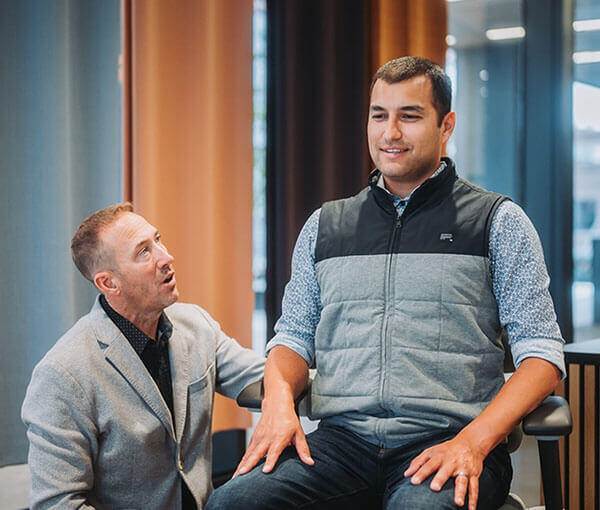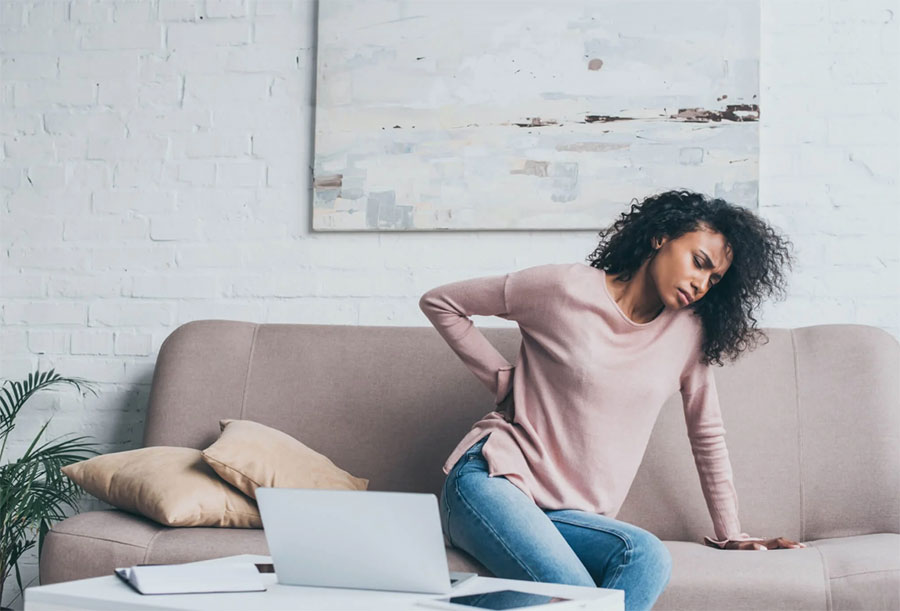If I asked that question to 100 people, I suspect I would hear:
“An ergonomic chair”
“A chair with lumbar support”
“A chair with a padded seat”
“Using a standing desk for sitting breaks during the day”
Let’s be honest, the answers I listed are the topics covered when we talk about sitting or choosing an office chair. What if I told you that we’ve been missing the mark?
I have spent most of my career as an occupational therapist specializing in wheelchair seating. Can we agree that people who use wheelchairs for daily mobility are the best examples of how to sit well and safely for prolonged periods of time? Interestingly, the principles we use for wheelchair seating have never been applied to able-bodied people who sit all day for work!
I’m here to tell you the real secret behind good sitting. And it’s not a single principle but a combination of principles, or “ingredients,” that make up the recipe for pain-free long-term sitting.
What Are the Ingredients of Pain-Free Sitting?
- Support your sitting foundation: the pelvis
- Elongate the spine
- Protect the sit bones and eliminate high-pressure areas
- Maintain good posture in a resting position
Support the sitting foundation- the pelvis
Think of your back as a building: the pelvis is the concrete foundation, and the rest of the spine represents the vertical floors of the building. You can hold up and position all that vertical weight (of the spine/of the building) in good alignment at the base without pain and for long periods of time.
The lumbar area of the back is above the base of the spine, corresponding to about the 5th floor of the building. Lumbar support, the industry standard for 30+ years, is like pushing on that 5th floor and expecting to support the entire building.
The whole office chair industry has been misleading the world that lumbar support will prevent pain in the lumbar spine and/or hold the spine in neutral!

“Lumbar supports have not been proven to reduce the incidence of low back pain” 1
The solution used in the wheelchair seating industry for years is to support the pelvis.
Supporting the pelvis does two things to reduce/prevent pain:
a. Supports the natural “S” curve of the spine
The pelvis is the key to posture and sitting. The spine will follow the pelvis to an upright “S” curve when the pelvis is supported in a neutral position. When unsupported, the pelvis tilts backward, and the spine falls into a forward-slumped “C” curve. The backward tilt or pelvic tuck is a huge culprit in back pain and poor posture. As described above, lumbar support is insufficient to support the pelvis in a neutral position and will ultimately lead to poor posture and pain.
b. Minimizes disc pressure
When the pelvis is properly supported, a positive ripple effect will occur in the rest of the body. Starting from the bottom, the lumbar spine moves into extension or a more neutral posture versus flexion and a rounded position. This motion reduces the lumbar disc pressure and relieves stress on pain-sensitive structures of the spine including the posterior longitudinal ligament.2 Supporting the pelvis also decreases the need for muscle activation to achieve an upright posture, increases disc space, and decreases pain.
Elongate the spine
You’ll notice when your pelvis is supported in a neutral position, your posture will be more upright, taking you away from the surface of the typical back support. This feels fine for a short period, but over time, the postural muscles automatically search for that support.
This leads to tucking the pelvis, resulting in a hunched posture, rounded shoulders, and forward head, which, we know, equals PAIN. Add to that a tall, wide back support, which promotes rounding forward and a forward head posture. Over time, these postures lead to strain and pain.
When the pelvis is stable, providing support to the upper back is key to elongating the spine and maintaining an upright posture over time.
Eliminate high-pressure areas—protect the sit bones
What’s the big deal about the seat? We’ve established that the pelvis is the foundation for good support. When the pelvis is held in a neutral posture, the sit bones are positioned directly underneath and are bearing the brunt of downward pressure. This is why supporting the pelvis at the seat surface through materials and contours is critical to alleviating these high pressures and maintaining postural alignment and comfort.


Why not mesh?
When sitting for long periods of time on a mesh seat or a hard surface, our sit bones cause high-pressure areas that result in discomfort. Most of us tuck our pelvis to relieve the pressure. This promotes a slouched posture with shoulders rolled in and the head held forward. So not only is posture compromised, but comfort is also affected by this inefficient posture, inducing, or increasing pain.
The conclusion was that the cushion contour had a greater effect on seat pan interface pressure parameters than the sitting posture. A greater uniformity of pressure distribution and a lower peak pressure implied an improvement of the user’s comfort on the seat. 3
This is why the seat design is so important!
Maintain good posture in resting position
A resting position is important in an office chair to take a phone call or just relax during the workday. Typically, recline is used as a resting position by opening the back angle, allowing the individual to lean back.
But the reclined posture causes backward rotation of the pelvis, resulting in that dreaded “C”-shaped spine and forward head posture. Reclining also causes forward migration of the hips on the seat .
This friction/shear/sliding can actually cause pain and pressure on the ITs and coccyx. Recline is a “resting” posture with unwanted side effects!
Tilt is a resting posture in which the seated posture and alignment are maintained when the whole system tilts rearward. Tilt reduces the pressure of gravity on the body while maintaining the neutral seated spinal alignment without inducing friction or sliding on the seated surface and avoiding the unwanted side effects of recline.
Is there an office chair that offers the four ingredients of pain free sitting?
If you are looking for a chair with the four ingredients of pain free sitting, look no further than Anthros.
Anthros is the only chair in the world that is guaranteed to improve posture, or your money back. The science-backed, patented design is registered with the FDA as a posture-improving chair and is proven to have the lowest pressure (most comfortable) cushion on the planet (verified by university testing).
Take the next step to reducing pain, increasing comfort, and maximizing performance!
References:
- Van Duijvenbode IC, Jellema P, van Poppel MN, van Tulder MW. Lumbar supports for prevention and treatment of low back pain. Cochrane Database Syst Rev. 2008 Apr 16;2008(2):CD001823. doi: 10.1002/14651858.CD001823.pub3. PMID: 18425875; PMCID: PMC7046130.
- Underwood MR, The Use of a Back Teaching Class teaching extension exercises in the treatment of acute low back pain in primary care, Oxford Univ, Great Britain, 1998
- Li W, Mo R, Yu S, Chu J, Hu Y, Wang L. The effects of the seat cushion contour and the sitting posture on surface pressure distribution and comfort during seated work. Int J Occup Med Environ Health. 2020 Sep 17;33(5):675-689. doi: 10.13075/ijomeh.1896.01582. Epub 2020 Jul 27. PMID: 32716013.
Recent Post

Four Lessons About Seating Everyone Can Learn from Wheelchair Users
September 18, 2025Working with wheelchair users has been an...

People Over Profits: Why Anthros Puts Comfort and Care First
September 17, 2025At Anthros, our mission is simple: to put people...










